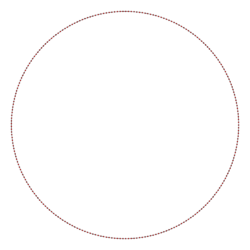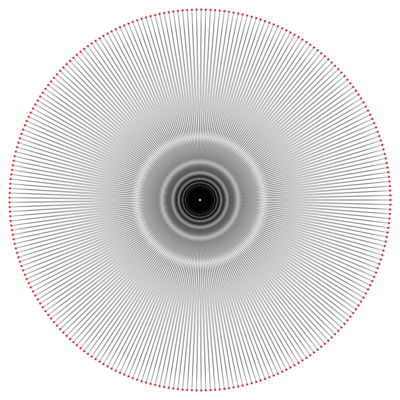257-gon
| Regular 257-gon | |
|---|---|
 A regular 257-gon | |
| Type | Regular polygon |
| Edges and vertices | 257 |
| Schläfli symbol | {257} |
| Coxeter diagram | |
| Symmetry group | Dihedral (D257), order 2×257 |
| Internal angle (degrees) | ≈178.599° |
| Dual polygon | Self |
| Properties | Convex, cyclic, equilateral, isogonal, isotoxal |
In geometry, a 257-gon is a polygon with 257 sides. The sum of the interior angles of any non-self-intersecting 257-gon is 45,900°.
Regular 257-gon
The area of a regular 257-gon is (with t = edge length)
A whole regular 257-gon is not visually discernible from a circle, and its perimeter differs from that of the circumscribed circle by about 24 parts per million.
Construction
The regular 257-gon (one with all sides equal and all angles equal) is of interest for being a constructible polygon: that is, it can be constructed using a compass and an unmarked straightedge. This is because 257 is a Fermat prime, being of the form 22n + 1 (in this case n = 3). Thus, the values and are 128-degree algebraic numbers, and like all constructible numbers they can be written using square roots and no higher-order roots.
Although it was known to Gauss by 1801 that the regular 257-gon was constructible, the first explicit constructions of a regular 257-gon were given by Magnus Georg Paucker (1822)[1] and Friedrich Julius Richelot (1832).[2] Another method involves the use of 150 circles, 24 being Carlyle circles: this method is pictured below. One of these Carlyle circles solves the quadratic equation x2 + x − 64 = 0.[3]
-
Step 1
-
Step 2
-
Step 3
-
Step 4
-
Step 5
-
Step 6
-
Step 7
-
Step 8
-
Step 9
Symmetry
The regular 257-gon has Dih257 symmetry, order 514. Since 257 is a prime number there is one subgroup with dihedral symmetry: Dih1, and 2 cyclic group symmetries: Z257, and Z1.
257-gram
A 257-gram is a 257-sided star polygon. As 257 is prime, there are 127 regular forms generated by Schläfli symbols {257/n} for all integers 2 ≤ n ≤ 128 as .
Below is a view of {257/128}, with 257 nearly radial edges, with its star vertex internal angles 180°/257 (~0.7°).
See also
- 17-gon
References
- ↑ Magnus Georg Paucker (1822). "Das regelmäßige Zweyhundersiebenundfunfzig-Eck im Kreise." (in de). Jahresverhandlungen der Kurländischen Gesellschaft für Literatur und Kunst 2: 188. https://books.google.com/books?id=aUJRAAAAcAAJ&q=%22Das+regelm%C3%A4%C3%9Fige+Zweyhundertsiebenundfunfzig-Eck%22+188&pg=PA188. Retrieved 8. December 2015.
- ↑ Friedrich Julius Richelot (1832). "De resolutione algebraica aequationis x257 = 1, ..." (in la). Journal für die reine und angewandte Mathematik 9: 1–26, 146–161, 209–230, 337–358. http://gdz.sub.uni-goettingen.de/dms/load/img/?PPN=PPN243919689_0009&DMDID=DMDLOG_0004. Retrieved 8. December 2015.
- ↑ DeTemple, Duane W. (Feb 1991). "Carlyle circles and Lemoine simplicity of polygon constructions". The American Mathematical Monthly 98 (2): 97–108. doi:10.2307/2323939. http://apollonius.math.nthu.edu.tw/d1/ne01/jyt/linkjstor/regular/1.pdf. Retrieved 6 November 2011.
External links
- Weisstein, Eric W.. "257-gon". http://mathworld.wolfram.com/257-gon.html.
- Robert Dixon Mathographics. New York: Dover, p. 53, 1991.
- Benjamin Bold, Famous Problems of Geometry and How to Solve Them. New York: Dover, p. 70, 1982. ISBN:978-0486242972
- H. S. M. Coxeter Introduction to Geometry, 2nd ed. New York: Wiley, 1969. Chapter 2, Regular polygons
- Leonard Eugene Dickson Constructions with Ruler and Compasses; Regular Polygons. Ch. 8 in Monographs on Topics of Modern Mathematics *Relevant to the Elementary Field (Ed. J. W. A. Young). New York: Dover, pp. 352–386, 1955.
- 257-gon, exact construction the 1st side using the quadratrix according of Hippias as an additional aid (German)
 |












